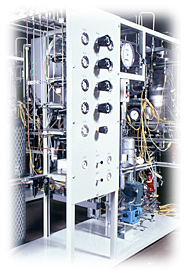|
The component chemicals of
petroleum are separated by distillation. Products based on
refined crude oil include kerosene, benzene, gasoline,
paraffin wax, asphalt, etc.
Strictly speaking, petroleum
consists entirely of hydrocarbons, compounds of hydrogen and
carbon.
The four lightest alkanes -
CH4
(methane),
C2H6 (ethane),
C3H8 (propane) and
C4H10 (butane) -
are all gases, boiling at -107°C, -67°C, -43°C, and -18°C,
respectively (-161°, -88°, -46°, and -1° degrees F).
The chains in the
C5-7
range are all light, easily vaporized,
clear naphthas. They are used as solvents, dry cleaning
fluids, and other quick-drying products. The chains from
C6H14 through
C12H26 are blended together and used for gasoline. Kerosene is
made up of chains in the
C10
to C15
range, followed by diesel
fuel/heating oil (C10
to C20) and heavier fuel oils as the
ones used in ship engines. These petroleum compounds are all
liquid at room temperature.
Lubricating oils and semi-solid greases (including Vaseline®)
range from
C16
up to C20.
Chains above
C20
form solids, starting with paraffin wax, then
tar and asphaltic bitumen.
Boiling ranges of petroleum atmospheric pressure distillation
fractions in degrees Celsius:
" petrol ether: 40 - 70 °C (used as solvent)
" light petrol: 60 - 100 °C (automobile fuel)
" heavy petrol: 100 - 150 °C (automobile fuel)
" light kerosene: 120 - 150 °C (household solvent and fuel)
" kerosene: 150 - 300 °C (jet engine fuel)
" gas oil: 250 - 350 °C (Diesel fuel/ heating)
" lubrication oil: > 300 °C (engine oil)
" remaining fractions: tar, asphalt, residual fuel
|

